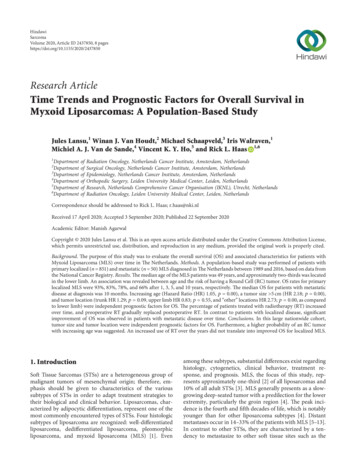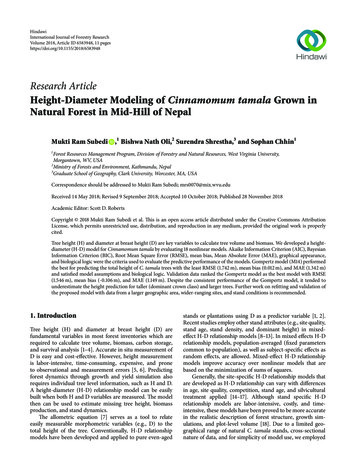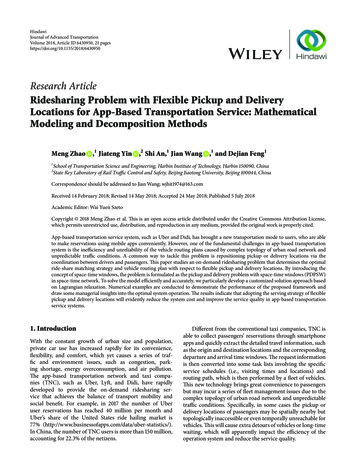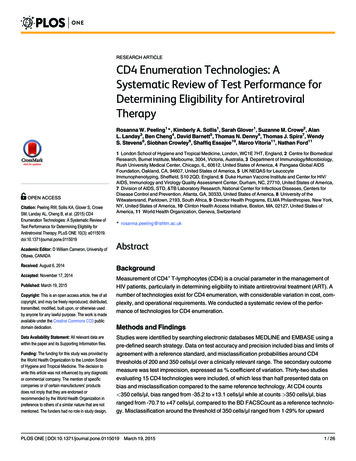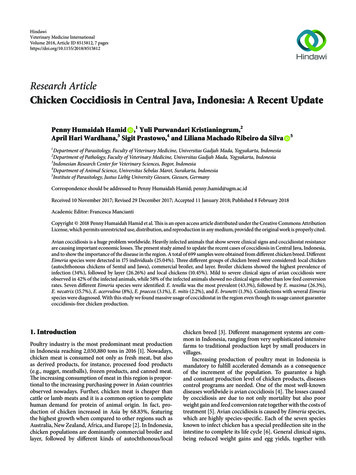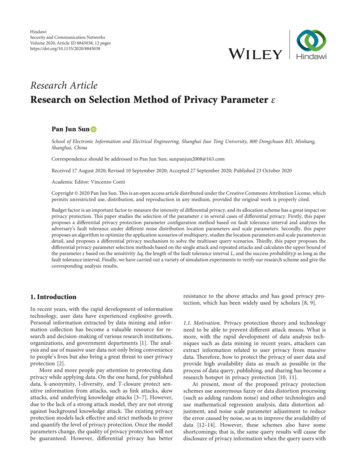
Transcription
HindawiSecurity and Communication NetworksVolume 2020, Article ID 8845038, 12 pageshttps://doi.org/10.1155/2020/8845038Research ArticleResearch on Selection Method of Privacy Parameter εPan Jun SunSchool of Electronic Information and Electrical Engineering, Shanghai Jiao Tong University, 800 Dongchuan RD, Minhang,Shanghai, ChinaCorrespondence should be addressed to Pan Jun Sun; sunpanjun2008@163.comReceived 17 August 2020; Revised 10 September 2020; Accepted 27 September 2020; Published 23 October 2020Academic Editor: Vincenzo ContiCopyright 2020 Pan Jun Sun. This is an open access article distributed under the Creative Commons Attribution License, whichpermits unrestricted use, distribution, and reproduction in any medium, provided the original work is properly cited.Budget factor is an important factor to measure the intensity of differential privacy, and its allocation scheme has a great impact onprivacy protection. This paper studies the selection of the parameter ε in several cases of differential privacy. Firstly, this paperproposes a differential privacy protection parameter configuration method based on fault tolerance interval and analyzes theadversaryʼs fault tolerance under different noise distribution location parameters and scale parameters. Secondly, this paperproposes an algorithm to optimize the application scenarios of multiquery, studies the location parameters and scale parameters indetail, and proposes a differential privacy mechanism to solve the multiuser query scenarios. Thirdly, this paper proposes thedifferential privacy parameter selection methods based on the single attack and repeated attacks and calculates the upper bound ofthe parameter ε based on the sensitivity Δq, the length of the fault tolerance interval L, and the success probabilityp as long as thefault tolerance interval. Finally, we have carried out a variety of simulation experiments to verify our research scheme and give thecorresponding analysis results.1. IntroductionIn recent years, with the rapid development of informationtechnology, user data have experienced explosive growth.Personal information extracted by data mining and information collection has become a valuable resource for research and decision-making of various research institutions,organizations, and government departments [1]. The analysis and use of massive user data not only bring convenienceto peopleʼs lives but also bring a great threat to user privacyprotection [2].More and more people pay attention to protecting dataprivacy while applying data. On the one hand, for publisheddata, k-anonymity, l-diversity, and T-closure protect sensitive information from attacks, such as link attacks, skewattacks, and underlying knowledge attacks [3–7]. However,due to the lack of a strong attack model, they are not strongagainst background knowledge attack. The existing privacyprotection models lack effective and strict methods to proveand quantify the level of privacy protection. Once the modelparameters change, the quality of privacy protection will notbe guaranteed. However, differential privacy has betterresistance to the above attacks and has good privacy protection, which has been widely used by scholars [8, 9].1.1. Motivation. Privacy protection theory and technologyneed to be able to prevent different attack means. What ismore, with the rapid development of data analysis techniques such as data mining in recent years, attackers canextract information related to user privacy from massivedata. Therefore, how to protect the privacy of user data andprovide high availability data as much as possible in theprocess of data query, publishing, and sharing has become aresearch hotspot in privacy protection [10, 11].At present, most of the proposed privacy protectionschemes use anonymous fuzzy or data distortion processing(such as adding random noise) and other technologies anduse mathematical regression analysis, data distortion adjustment, and noise scale parameter adjustment to reducethe error caused by noise, so as to improve the availability ofdata [12–14]. However, these schemes also have someshortcomings; that is, the same query results will cause thedisclosure of privacy information when the query users with
2Security and Communication Networksdifferent permissions and reputation levels query the sensitive data.The differential method has become a hot research topic onmany practical applications in recent years. Compared with thetraditional privacy protection mode, differential privacy has itsunique advantages. Firstly, the model assumes that the adversaryhas the greatest background knowledge. Secondly, differentialprivacy has a solid mathematical foundation, a strict definition ofprivacy protection, and a reliable quantitative evaluationmethod. By using the output perturbation technology to addrandom noise to the query output, the single record is in thedataset or not in the dataset, which has little impact on thecalculation results. Even if the adversary has the maximumbackground knowledge, it can ensure that the adversary cannotobtain accurate individual information by observing the calculation results.The research work of differential privacy protectionmainly focuses on improving the privacy protection and datautility in the differential privacy data release, but a smallamount of strict mathematical reasoning and research isconducted on the configuration method of privacy protection parameters in the specific practice of differentialprivacy. In practice, the dataset size, query function sensitivity, and privacy protection probability threshold shouldbe considered in the configuration of privacy protectionparameters.Differential privacy is based on a good mathematicalbasis and can quantitatively describe the problem of privacydisclosure [1]. These two unique features make it differentfrom other methods. Even in the worst case, if an adversaryknows all the sensitive data except one record, it can ensurethat the sensitive information will not be disclosed, becausethe adversary cannot judge whether the record is in thedataset from the query output [2].The research of differential privacy protection technology mainly considers three problems: (1) how to ensure thatthe designed privacy algorithm meets the differential privacyto ensure that the data privacy is not leaked; (2) how toreduce the error probability to improve the availability ofdata; (3) in the face of different environments and attackmodes, how to determine the value range of parameter ε andgive a credible and reasonable reasoning proof process.1.2. Contributions. Aiming at the above problems, to ensurethe privacy and availability of sensitive data in the process ofdata query, solve the problem of real data informationleakage in the process of data, and reduce the probability ofattackers to obtain real results through differential attack andprobabilistic reasoning attack, we study the differentialprivacy parameter selection methods in various situations;these specific contributions are as follows:(i) We propose a differential privacy parameter configuration method based on fault tolerance intervaland analyze the adversaryʼs fault tolerance underdifferent noise distribution location parameters andscale parameters and study the influence of theuser’s query permission on privacy protection parameter configuration.(ii) We study the location parameters and scale parameters in detail and propose a differential privacymechanism to solve the multi-user query scenarios.(iii) For a single attack, we propose a differential privacyattack algorithm and calculate the upper bound ofthe parameter ε based on the sensitivity Δq, thelength of the fault tolerance interval L, and thesuccess probability p. Furthermore, we propose anattack model to achieve the security of differentialprivacy protection technology under repeated attacks, analyze the results of repeated attacks and thecharacteristics of noise distribution function toobtain the probability of noise falling into the faulttolerant interval, deduce the probability of theadversaryʼs successful attack by the permutation andcombination method, and then obtain the selectionrange of parameter ε.(iv) We design several experiments, analyze the relationship between adversaryʼs fault tolerance andprivacy parameters, derive the configuration formula of the privacy parameter ε, and configureappropriate parameters without violating the privacy probability threshold.This paper studies the selection of the parameter ε inthree cases of differential privacy. The structure of this paperis as follows. In Section 2, we introduce and analyze theresearch progress of correlation differential privacy parameters. In Section 3, we introduce the concept and theoryof differential privacy. In Section 4, we propose a privacyparameter selection method-based fault tolerance and analyze the case of multiple scale parameters. In Section 5, wepropose a differential privacy algorithm for a multi-userquery. In Section 6, we introduce the query attack mode indifferential privacy. In Section 7, we design relevant experiments and show the characteristics of the study throughanalysis and comparison. In Section 8, we summarize andpropose future work.2. Related WorkRecently, many achievements have been made in differentialprivacy research. At present, the research of differentialprivacy protection technology combines database theory,cluster algorithm, statistical knowledge, and modern cryptography [1, 2]. It defines a very strict mathematical modeland provides rigorous and quantitative representation andproof of privacy leakage risk [3–7, 15]. Based on the relevance contents, this paper divides the research work ofdifferential privacy protection into two parts.2.1. Research on the Basic Theory of Differential Privacy.How to reduce the noise of dataset on the premise of differential privacy: Yi and Zhabin [16] proposed a datapublishing algorithm based on wavelet transform, which caneffectively reduce the size of ε parameter and improve theaccuracy of the histogram counting query. Park and Hon[10] studied parameter ε to protect differential privacy and
Security and Communication Networksintroduced a new attack index to capture the relationshipbetween attack probability and privacy assurance. Yao [12]introduced the concept of α-mutual information securityand showed that statistical security meant mutual information security. Du and Wang [13] proposed a query modeland implemented differential privacy by Laplace noise. Tsouand Chen [17] quantified the disclosure risk and linked thedifferential privacy with k-anonymity. Zhang and Liu [18]proposed a privacy-preserving decision tree classificationmodel based on differential privacy mechanism, through theLaplace mechanism and index mechanism, which providedusers with a secure data access interface and optimized thesearch scheme to reduce the error rate.Lin et al. [19] proposed an optimized differential privateonline transaction scheme for online banking, which setconsumption boundary with additional noise, and selecteddifferent boundaries while satisfying the definition of differential privacy. Besides, they provided a theoreticalanalysis to prove that the scheme can meet the differentialprivacy restriction. The choice of a privacy mechanismusually does not have a significant impact on performancebut is critical to maintaining the usability of the result.Goryczka and Xiong [20] described and compared distributed data aggregation methods with security and confidentiality, studied the secure multiparty addition protocol,and proposed a new effective Laplace mechanism, ensuringthe security of computation, the minimum communicationtraffic, and the high reliability of the system. Kang and Li [21]proposed a new framework based on the concept of differential privacy, by purposefully adding noise to locallyperturb its training parameters, which achieved a compromise between the convergence performance and privacyprotection level.Li et al. [22] focused on the linear query function basedon Laplacian mechanism and proposed a method to determine the upper bound of the number of linear queriesfrom the perspective of information theory. Huang andZhou [23] proposed a differential privacy mechanism tooptimize the number of queries in multi-user scenarios andanalyzed the distortion of data distribution and the absolutevalue of noise in terms of utility. Ye and Alexander [15]studied the minimax estimation problem under the restriction of the discrete distribution in the privacy of differential privacy, under the given conditions, consideringthe structure ε- privacy level of the optimal problem of theprivatization program, minimizing expected estimatedlosses.2.2. Application of Differential Privacy. Differential privacyhas a wide range of applications. Cheng et al. [11] realizedthe private publishing of high-dimensional data and determined the optimal parameters by non-overlapping coverage. The studies in [14, 24] introduced differential privacyto protect data privacy and prevented the adversary frominferring important sensitive information. Due to the highcomplexity and multi-dimension of data, [25] proposed adata partition technology and further used the interactivedifferential privacy strategy to resist the privacy leakage.3Based on noise estimation and Laplace mechanism, the workin [26] studied the trade-off relationship between privacyand utility, derived the optimal differential privacy mechanism, and effectively adapted to the needs of personalizedprivacy protection.Zhang et al. [27] formally studied the issue of privacypreserving set-value data publishing on hybrid cloud, provided a complete system framework, and designed a newdata partition mechanism, further setting up query analysistools that can be automatically switched on the structure ofthe query optimization of hybrid cloud data query, ensuringthe confidentiality of data. In a voting system, users canreport their desired parameter values to the selectormechanism. Without limiting user preferences, [28] struck abalance between protecting personal privacy and returnedaccurate results through the parameter epsilon control.Sun and Tay [29] constructed an optimization framework that combined local variance privacy and inferentialprivacy measures and proposed a two-stage local privacymapping model that can achieve information privacy andlocal variance privacy within a predetermined budget. Caoand Yoshikawa [30] studied the potential privacy loss of atraditional differential privacy mechanism under time dependence, analyzed the privacy loss of adversaries with timedependence, and designed a fast algorithm to quantify thetime privacy leakage. Based on the differential privacymodel, the study in [31] constructed a privacy protectionmethod based on clustering and noise and proposed aprivacy measurement algorithm based on adjacency degree,which can objectively evaluate the privacy protectionstrength of various schemes and prevent graph structure anddegree attacks.In the cloud service, the study in [32] proposed a priorityranking query information retrieval scheme to reduce thequery overhead on the cloud. The higher-ranking query canretrieve a higher percentage of matching files; users canretrieve files on demand by selecting different levels ofqueries. Sun and Wang [33] proposed a weight calculationsystem based on the classification regression tree method,which combined differential privacy and decision treemethod, and used differential private small-batch gradientdescent algorithm to track privacy loss and prevented adversary from invading personal privacy. Chamikara et al.[34] proposed a recognition protocol, which used differentprivacy to disturb the featured face and stored the data in athird-party server, which can effectively prevent attacks suchas member inference and model memory attacks.To determine the reasonable release time of dynamicpositioning data, the study in [35] designed an adaptivesampling method based on proportional integral derivativecontroller and proposed a heuristic quadtree partitionmethod and a privacy budget allocation strategy to protectthe difference privacy of published data, which improved theaccuracy of statistical query and improved the availability ofpublished data. There is often a trade-off between privacyand mining results. Xu and Jiang [36] described the interaction between users in the distributed classification scenario, constructed a Bayes classifier, and proposed analgorithm that allowed users to change their privacy budget;
4Security and Communication Networksusers can add noise to meet different privacy standards. Yinand Xi [37] combined practicability with privacy to establisha multi-level location information tree model and used theindex mechanism of differential privacy to noise the accessfrequency of selected data.3. Basic ConceptsHere, this paper will introduce some concepts of differentialprivacy and related theories.Definition 1 (Adjacent dataset) [1]. Given the dataset D andD′ with the same attribute structure, when the number ofrecords difference is 1, the datasets D and D′ are calledadjacent datasets.Definition 2 (Differential privacy) [1]. A random algorithmA satisfies ε differential privacy, if and only if, for any twosets D, D′ and any output S with only one tuple difference,the following conditions are met: Prob(A(D)) S ε Prob A D′ S e ,(1)where ε is a constant number of the user. Both D and D′differ by at most one tuple; e is a natural logarithm constant.When the parameter ε is small enough, it is difficult for anadversary to distinguish whether the query function acts onD or on D′ for the same output S.Definition 3 (Global sensitivity) [1]. There is a functionq: D Rd ; the global sensitivity Δq of function q isexpressed as follows: Δq max q(D) q D′ 1 ,(2)D,D′where D and D′ are adjacent datasets, d is the dimension offunction q, and ‖q(D) q(D′ )‖1 is the 1-order norm distance between q(D) and q(D′ ).Definition 4 (Laplace mechanism) [1]. It adds independentnoise to the true answer and uses Lap(b) to represent thenoise from Laplace distribution with a scaling parameter b.For a function q; D R over a dataset D, the mechanism A provides the ε-differential privacy:A(D) q(D) Lap Δq .ε(3)For query q on the database D, the random algorithmA returns q(D) x to the user based on a query resultq(D) and adds the noise x to satisfy the Laplace distribution. In the theory of probability and statistics, theprobability density function of variable x is expressed asfollows:f(x μ, b) 1 (x e2bu/b) 1 ((x μ)/b) ,e 2F(x) f(μ)dμ 1 1 e ((x μ)/b) ,21 1 sign(s μ) 1 e ( x μ /b) .2 2x(4).x μ,x μ,(5)This is the Laplace distribution, μ is the position parameter, and b 0 is the scale parameter, and x is the samplevalue that satisfies the f(μ, b) Laplace distribution:x f(μ, b), b (Δq/ε); notice that the larger the ε, thesmaller the b. For the convenience of discussion, μ 0; theexpectation and variance are μ and 2b2 , respectively. Theimplementation of ε-differential privacy algorithm is relatively simple. From Laplace distribution f(μ, b), the locationparameter μ does not affect the adversary, while the parameter b (Δq/ε) directly affects the vulnerability of theattack. When the parameter b is smaller, the sampling data xis closer to the location parameter μ; on the contrary, whenthe parameter b is large enough, the sampling data x is equalto the average distribution on ( , ), which is verydifficult for the adversary.Definition 5 ((α, β) useful) (see [1, 38]). A mechanism Ameets the (α, β) useful; it has the formulafd6 Prob Ai (D) Aj (D) a 1 β,(6)where α and β are the accuracy parameters and Aj is theprivate algorithm of Ai .Theory 1 (Sequential composition theory [2]). ForA1 , A2 , . . . , Ak , they satisfyε1 -difference privacy, ε2 -difference privacy, and εk -differential privacy. When they areapplied to the same dataset, publishing resultst t1 , t2 , . . . , tk meet the ki 1 εi -differential privacy,t1 A1 (D), t2 A2 (D), . . . , tk Ak (D).Theory 2 (Parallel composition theory [2]). AProb( Ai (D) Aj (D) a) 1 β dataset D is divided intok units, D1 , D2 , . . . , Dk , respectively, so that A1 , A2 , . . . , Akcansatisfyε 1 , ε2 , . . . , ε kdifferentialprivacy,t 〈t1 , t2 , . . . , tk 〉 can satisfy maxi [1,2,.,k] εi -differentialprivacy.Theory 3 (Medium convexity theory [38]). Given that twoalgorithms A1 and A2 satisfy ε-differential privacy, for anyprobability p [0, 1], Ap is used as a mechanism. It uses thealgorithm A1 with the probability p and uses the A2 algorithm with the probability 1 p; then the A2 mechanismsatisfies the ε-differential privacy.
Security and Communication Networks54. Privacy Parameter Selection Based onFault ToleranceThe query value of the adversary is generated based on thereal value; the distribution of noise directly affects theprobability of the adversary obtaining the real information.4.1. Privacy Fault Tolerance. For some query functions, if thenoise x is distributed in [ L, L](L 0), the adversary caninfer the true value f(x) with a large probability and thenanalyze whether a specific record is in or not in the dataset.In this paper, [ L, L] is called the fault tolerance interval,and the corresponding fault tolerance is fatl(x).According to the Laplace definition, the probability thatthe random noise x lies in the fault tolerance F(x) can beobtained by F(L) F( L). Thus, the mathematical expression of the adversaryʼs fault tolerance fatl(x) is obtainedas follows:1μ Lμ L μ L L, exp exp , 2bb L 1μ L L μfatl(x) F(L) F( L) f(μ)dμ 1 exp exp , L μ L, 2bb L 1 exp L μ exp L μ , L L μ.2bbThrough this mathematical theory analysis, we can selectappropriate privacy parameters ε and add noise that meetsthe requirements of differential privacy protection, to prevent the adversaryʼs probabilistic reasoning attack.4.2. Analysis of Privacy Parameter. When the adversaryʼsfault tolerance level satisfies the privacy probabilitythreshold, the appropriate scale parameter value can beobtained. In this method, the privacy probability thresholdPTpr (0, 1) is determined by the privacy attribute, whichmeans that the adversaryʼs probabilistic inference attack willnot exceed the privacy protection threshold.To meet the requirements of privacy protection, the scaleparameter b can meet the formulaLfatl(x) F(L) F( L) Lf(μ)dμ PTpr .(8)The mathematical expression of fault tolerance fatl(x)has many forms according to the different position parameters μ.(1) When μ L L, we can get the formula(7)1μ Lμ Lfatl(x) exp exp PTpr2bbμ Lμ L exp 2PTpr exp bb2PTprμ L μ L exp(μ L/b)bbexp(μ L/b) PTpr LbPTμ Lpr ln b LbPTpr b2 1 ln b L μ 0.L(9) (2) When b 0, by solving the formula (8), we can getthe formula 21 ln PTpr /L 1 ln PTpr /L 4 (L μ)b .2(10)(3) When L μ L, we can get the formula
6Security and Communication Networksfatl(x) 1 (4) when b 0, by solving the above inequality, we canobtain the formulafd121μ a a μ exp exp PTpr2bb2μμ L exp 1 2 1 PTpr exp bb2μ μ L ln 2 1 PTpr exp bb b ln 2 1 PTpr 2μ ln(μ L) ln b μ Lb b(ln b) 1 b2 ln 2 1 PTpr μ Lln 2 1 PTpr u L b ln(μ L) 2μ 0 b2 [1 ln(u L)]b 2u 0.(11) [1 ln(μ L)] [1 ln(μ L)]2 8μ 1 ln 2 1 PTpr /μ L b .2 1 ln 2 1 PTpr /μ L (5) When L L μ, formula (8) can be rewritten asfollows:fd13b2 1 lnL b L μ 0.PTpr(12)(13)Budget parameter ε configuration can be expressed asfollows:2Δf ,μ L L, 2 1 lnPT/L 1 lnPT/L 4(L μ) prpr 2Δf 1 ln 2 1 PTpr /u L , L μ Lε 2 1 ln(μ L) [1 ln(μ L)] 8μ 1 ln 2 1 PTpr /u L 2Δf , L L μ. 1 ln L/PTpr 1 ln L/PTpr 2 4(L μ) From the above analysis, we can deduce the selection rangeof privacy parameter ε under different location parameters, scaleparameters, and privacy probability thresholds.(14)In this paper, the value range of query authority is set as[0, 1]. To configure smaller privacy protection budget parameters to users with low query rights, the privacy budget
Security and Communication Networks7parameter ε′ εPb is set. Based on this, the configurationmethod of privacy parameter ε′ under different querypermissions can be obtained by the following formula:2ΔfPb ,μ L L, 2 1 ln PTpr /L 1 ln PTpr /L 4(L μ) 2Δf 1 ln 2 1 PTpr /μ L Pb , L μ L,ε′ εPb 1 ln(μ L) [1 ln(μ L)]2 8u 1 ln 2 1 PTpr /μ L 2ΔfPb , L L μ. 1 ln L/PT 1 ln L/PT 2 4(L μ) prprThrough this privacy parameter configuration method,the privacy protection probability threshold can be set, andthe appropriate privacy parameter ε can be selectedaccording to the query function and the fault tolerance, so asto achieve the privacy protection and ensure the maximization of data utility.5. Differential Privacy of Multiuser QueryIn this section, we continue to study the location parametersand scale parameters and propose a differential privacymechanism to solve the multi-user query.Assume that the number of users is m, and the querynumber of each user is k. The query set isQ qij i [m], j [k] ; the results for ith user are coveredwith scale parameter b (Δq/ε) and location parameteru ui . The ui is randomly chosen from the interval[μ L, μ L].According to Definition 3, the global sensitivity is Δq, the rij rij xij is the noisy value of the query qij by the database D, the rij is the real value of the qij , and xij is noisewith b (kΔq/ε) and μ μi . The rij′ rij′ xij′ is the noisyvalue answer of the query qij by the database D′ , xij′ is thenoisy value for qij by the database D′ , and rij′ is the real valuefor qij by the database D′ .Theory 4. For the database D and query set Q, the mechanism A is ε-differential privacy.Proof. For the D, D′ and the ith userʼs query qij , the locationparameter is μi , so it can get the formulaProb rij A(D) P rij xij P xij A(D) rij .(16)xij meets the Laplace distribution; it can get the formula ε A(D) rij μi ε . Prob xij A(D) rij e kΔq2kΔq(17)For the adjacent database, it can get the formulaProb rij′ A D′ εekΔq ε A(D) rij′ μi /kΔq (15).(18)For the ith user’s query qij , it can get the formula Prob xij (ε/2kΔq)e ε A(D) rij μi /kΔq Prob xij′ (ε/2kΔq)e ε A D′ r ′ μ /kΔq iji ε A(D) rij μi ε A D′ rij′ μi e kΔqkΔq (ε/kΔq) rij rij′ e(ε/k) . e(19)In Algorithm 1, there are some denotations. The database is denoted by D and its global sensitivity is Δ D. for thequery qij of the ith user, the privacy budget is (ε/k).According to Theory1 of differential privacy for the query setQ, this mechanism is ε differential privacy. 6. Research of the Attack ModelIn the actual application scenario, users often face attackproblems of different privacy. This section is divided intotwo parts: single attack and repeated attack.6.1. Single Attack. Assume that there are only two potentialinput sets in the worst case, this section discusses how toguess the real value q(D) according to the q(D) x. Anadversary puts forward a query question q against the attackobject. The database owner gets the result q(D) according tothe query question and returns it to the adversary afteradding the noise x. The adversary needs to make a judgmentby the result q(D) x; an attack object is not in the collection. Each noise x satisfies the Laplace distribution, so it isimpossible for the adversary to accurately guess this x.Considering the characteristics of query functions, the adversary can only guess that x falls in a certain range. Todescribe the above phenomenon, the probability of x ininterval [μ L, μ L] decreases with the increase of b, whichcan reflect the difficulty of the adversary.
8Security and Communication NetworksRequire: the number of user is mThe number of query for each user is kThe query set is QThe interval is [μ L, μ L]The database D and its global sensitivity is ΔqThe privacy budget is εEnsure: the set of answer rij for queries(1) For each user i [n] do(2) Choose μi from [μ L, μ L] for ith user(3) Set the ith user’s noise distribution lap((kΔq/ε), μi )(4) For each query qij Q do(5) The answer rij qij (D) lap((kΔq/ε), μi )(6) EndALGORITHM 1: Multi-user query.Lemma 1. If the Laplace distribution is used to add noise x toq(D), then the probability of q(D) x in the interval( , Q(D) μ L) is expressed as 1 (1/2)e( Lε/Δq) .Proof. Based on Definition 3, the probability of q(D) xfalling in the interval ( , q(D) μ L) is equal to theprobability of x in the interval ( , μ L). Therefore, fromthe Laplace function, according to b (Δq/ε), the probability of x in the interval ( , μ L) is expressed asF(μ L) (1/2) (1/2)(1 e( L/b) ) 1 (1/2)( L/b) . Lemma 2. The probability of an adversaryʼs success inAlgorithm 2 is 1 (e( ε/2) /2).Proof. Assume that q(D) m or q(D) m 1; there aretwo intervals ( , m 0.5) and [m 0.5, ) forq(D) x. From Theory1, if q(D) m, the probability ofq(D) x in the ( , m 0.5) is 1 (e( ε/2) /2). Ifq(D) m 1, the probability of q(D) x in the[m 0.5, ) is the same.Therefore, according to q(D) x, the probability ofsuccess is 1 (e( ε/2) /2); if q(D) x falls into the ( , m 0.5) interval, then q(D) m; otherwise, q(D) m 1.Note: q(D
the ,and (/ ′ ′ ′ ′, ′ ′ ′ ′.,′ () (. ( ( . (17) ′ ′ () ′ /. ′ ()( / / ( (/)′ (/). /). (() (() .
